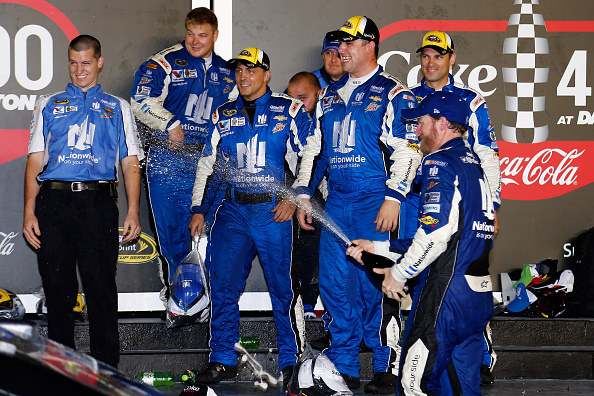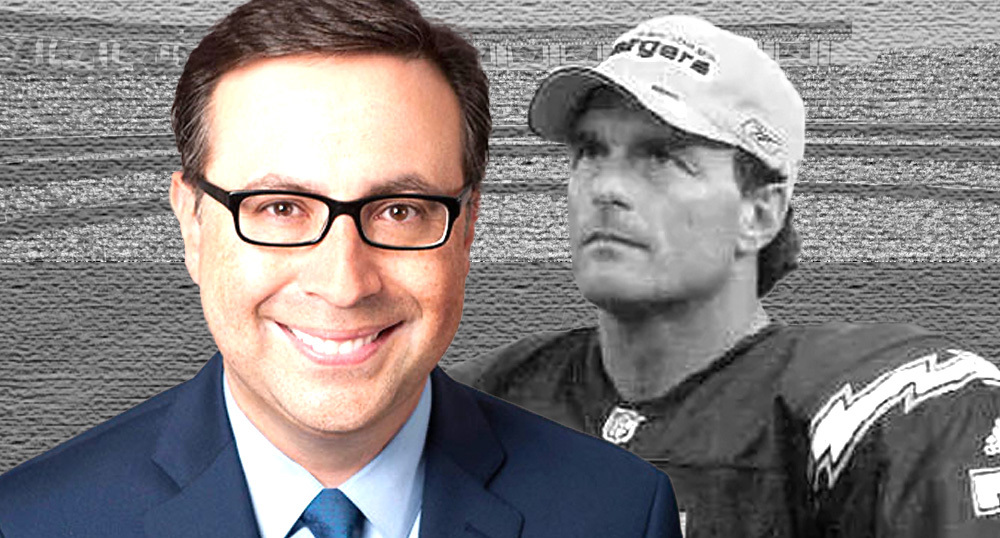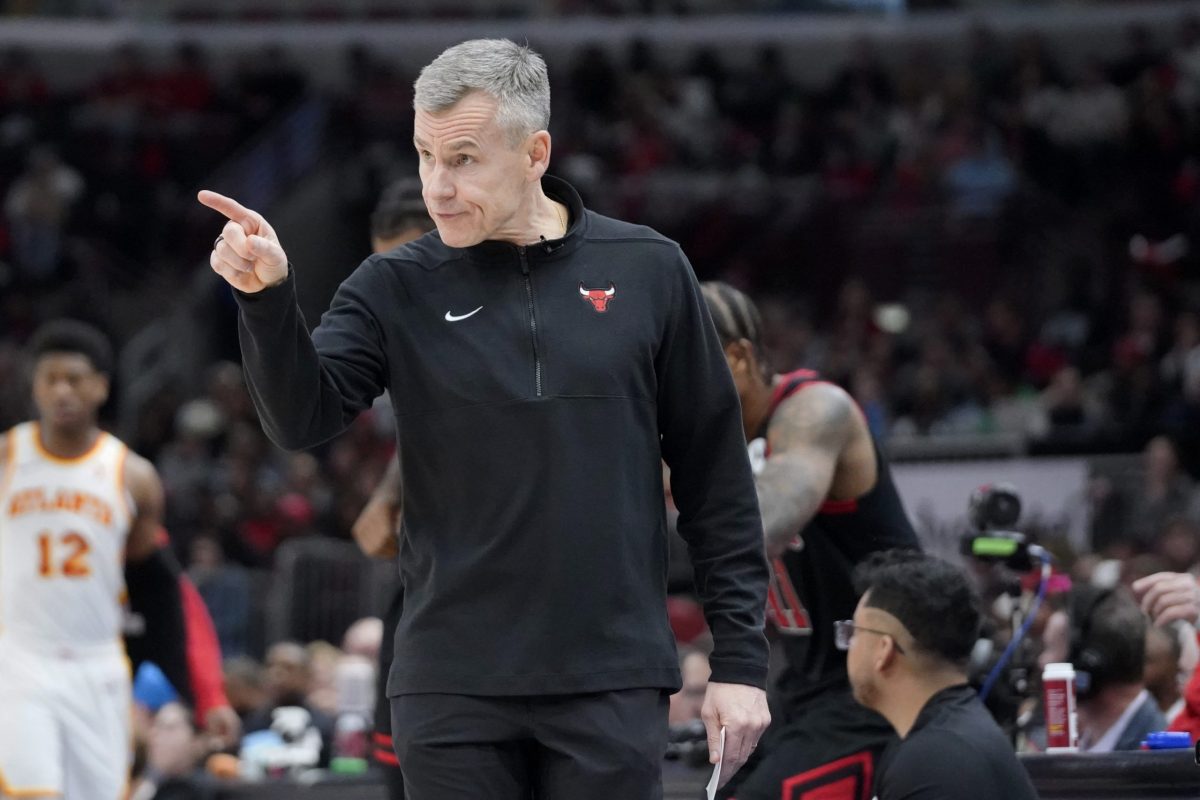In a 10 year deal signed last year, NBC is back in NASCAR. Once broadcasting NASCAR races from 1999-2006, NBC took over from TNT and ESPN to show the last half of the NASCAR Sprint Cup and XFINITY Series races on the NBC family of networks.
To say they had their challenges Sunday night in the Coke Zero 400 at Daytona International Speedway, as they had to get through a four-hour rain delay as well as being in direct competition with the Women’s World Cup Final, would be an understatement. It wasn’t NBC’s dream scenario to start their return to NASCAR race coverage but they rolled with the punches and performed admirably.
Crew
NBC’s crew contains a mix of on air veterans coming from various networks to rookies who are new to the TV side of the sport. Up in the broadcasting booth, Rick Allen brings years of broadcasting experience by being the voice of the then Craftsman, now Camping World Truck Series for FOX. Jeff Burton and Steve Letarte, who are new to TV commentary, join Allen. Burton is a highly respected NASCAR driver among fellow drivers and fans. When Burton raced full time, he was one of the few where everyone listened when he had something to say. Letarte brings decades of knowledge on the pit crew side of the team, being Crew Chief for Jeff Gordon and Dale Earnhardt Jr. For Burton and Letarte, while they are new, they have been able to get experience by being on NBCSN’s studio show “NASCAR America.” That experience provided a seamless transition and it showed as Burton and Letarte looked like they had been commentating on NASCAR races for years.
For their prerace show, Krista Voda, Dale Jarrett and Kyle Petty take control of the coverage. All three have had experience in NASCAR prerace coverage TV with FOX (Voda and Petty) and ESPN (Jarrett). Rutledge Wood and Nate Ryan are reporters for the prerace show and they take different approaches to their interviewing styles. Wood, one of the hosts of U.S. Top Gear, takes a more personable approach and asks generalized and personalized questions instead of questions based on race strategy. Ryan, formerly a writer for USA Today, does take more of the race strategy approach and creates a well-rounded approach to the prerace show.
NBC’s pit reporters (Dave Burns, Mike Massaro, Marty Snider and Kelli Stavast) all have experience reporting on NASCAR for other networks and in Snider’s and Stavast’s case, are also pit reporters for NBC’s IndyCar races.
Rain Delay
NBC’s first race in nine years started with a rain delay, a nightmare for a network to cover. It’s your first race, you’re on network TV and now you have to fill four hours of non-racing with driver interviews and pre-taped segments. Rain delays are a necessary evil in NASCAR and NBC did the best they can. They almost went to every driver at some point during the rain delay to interview them and updated the TV audience about when to expect them to go racing. I’m sure NBC would like to go racing at 7:00 instead of 11:30 but that is what it is.
Race Coverage
First of all, thank you NBC for NBC Live Extra!!! I had to DVR the race because I wasn’t up to pull an all-nighter and I could only record until four hours after the broadcast was supposed to end at 11:00 PM. At 3:00 AM, the DVR shut off and they were still racing and I missed the last part of the race. I went on my Apple TV to their NBC Live Extra and not only did they have the race broadcast, there were 10 total feeds for you to choose. We had feeds that had commentators or no commentators, feeds focusing on certain drivers, overhead cams and everything in between. I kind of wish for the driver feeds, they would include their radio feed but that may be dangerous since it would be uncensored. Regardless, this is something I wish every sport had so thank you NBC. I don’t know if NBC is going to be doing as many feeds every week but here were the complete list of feeds on NBC Live Extra for Daytona.
- Regular broadcast with announcers
- Leader Cam (following leader) and Battle Cam (following battles for position) with announcers and regular broadcast (in split screen)
- Danica Patrick and Dale Earnhardt Jr. Cam with announcers and regular broadcast (in split screen)
- Kevin Harvick and Tony Stewart Cam with announcers and regular broadcast (in split screen)
- Leader Cam and Turn 4 Cam (end of Pit Road) with announcers
- Danica Patrick, Dale Earnhardt Jr. and Kevin Harvick Cam without announcers
- Leader Cam, Battle Cam and Turn 4 Cam without announcers
- Overhead Cam (view from blimp and full screen) without announcers
- Battle Cam (full screen) without announcers
- Turn 4 Cam (full screen) without announcers
For the race, NBC took their approach to the race like they have handled coverage of other sports, namely the English Premier League. Like their EPL coverage, NBC went with a no nonsense, but entertaining and informative approach, and assumed the audience already knew the basics of NASCAR. Some broadcasts take into consideration some fans are watching NASCAR for the first time so they take time out at various points to point out the basics. That might be helpful the first time but it really gets tiring for those who have been watching for years as well as those who had been new and are already past that.
NBC already assumes you know what the difference between “loose” and “tight” is and goes next level with explaining the nuances of NASCAR. For instance, at one point, Rick Allen pointed out a new concept of a light on the back of the pace car that debuted this race. That light would let the drivers know if Pit Road was open (green) or closed (red) during caution.
NBC did some little things that were new. During cautions and all the cars were going down Pit Road, NBC not only showed four cars to focus on, they also showed a map of where those cars were pitting in relation to the rest of the field. NBC also showed messages from race control in their score bug to tell the audience when the race was going back to green and if the pits were going to open.
One thing that I liked that may go unappreciated was that their broadcast, especially in the final stages of the race, had a more conventional style and had fewer camera cuts. Years ago, when NASCAR broadcasts only had 10 to 15 cameras to cover a race, there were far fewer camera cuts compared to broadcasts today with over 60 cameras covering every part of the track. It can very easily become a Michael Bay film with quick cuts every few seconds from the track to an in-car to the track to the pits to another in-car with a split screen to a driver’s wife or girlfriend. It can all be very disorienting and rather unnecessary. NBC took the “less is more” approach and kept camera cuts, and more importantly split screen views, to a minimum as they got to the end of the race.
Speaking of the end of the race, NBC was faced with a delicate and serious situation. As Dale Earnhardt Jr. crossed the finish line to win, Austin Dillon was spun and flipped into the catch fence, immediately stopping to a standstill from 200 mph to 0 mph with parts scattered into the crowd and the racetrack. Not immediately knowing Dillon’s condition as well as those in the stands, Allen, Burton and Letarte took things very serious and cautious in terms of the crash. It wasn’t until Dillon got out of the flipped car that NBC got a little more relaxed but still serious because of the fans. Burton and Letarte did a fantastic job describing how a crash like that, particularly going from 200 mph to 0 mph in an instant, can be the most dangerous crash of all.
Another small detail that shouldn’t go unnoticed. NASCAR broadcasts typically like to play the audio of the winning driver as they cross the line because they’re usually happy to win and it’s a great moment. When the cars crossed the line and Dale Jr. saw his friend launch into the fence, he reacted like any normal person would do, with a bunch of expletives and worried about how his friend was instead of celebrating the win. The person in charge of the audio cut off the transmission before Dale Jr. went into the expletives.
As you can tell, I really didn’t have many issues with NBC’s broadcast. I thought it was stellar and it’s something that’s just going to improve on over time. If I had to pick one thing that I noticed that could be worked on, I thought Jeff Burton could’ve spoken up some more because Steve Letarte was at some points of the broadcast, giving analysis from the Crew Chief’s point of view as well as the driver’s point of view, which is supposed to be Burton’s realm. Nothing against Letarte, he definitely knows his stuff so it’s not like he doesn’t know what he’s talking about, but it seems a little strange when he was giving thoughts on what the driver could be thinking when a 20 year NASCAR Sprint Cup veteran is in the booth. It’s a great problem to have.
The important thing NBC did was that they did the little things right and didn’t wrap their coverage around some big new thing to try to bring people in. Instead of relying on a gimmick to win fans over, they went out and focused on getting the fundamentals right. NBC didn’t reinvent the wheel with their NASCAR coverage but they polished the wheel and made it shine brighter than it has been in years. I’m looking forward to seeing what else NBC has to offer in the future with their NASCAR coverage.







Comments are closed.